Login or Register
Before you can subscribe to premium, you need an account. Please log in or register.
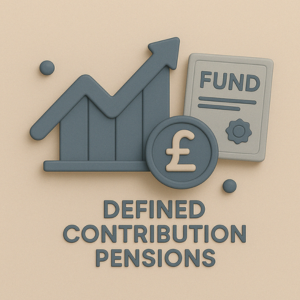
In a defined contribution pension, payments are made by you, your employer, or both. If it's a workplace scheme, contributions usually come straight from your salary. If it's a personal pension, you pay in yourself.
Your money is invested, so its value can rise or fall. Unless you choose your own funds, your provider will use a default investment strategy, often higher risk when you’re younger and lower risk as you near retirement.
Pension funds are typically invested in property, shares, bonds, or a mix of assets to help your pot grow over time.
The amount you get depends on how much you and your employer pay in, how long you save, how well your investments perform, and any fees charged by your provider.
You can check your pot’s value and income estimate by logging in to your provider’s website or app. You’ll also get an annual statement with a retirement income projection.
With a defined contribution pension, your pension pot is usually invested in a range of funds to help it grow over time. These can include stocks and shares, bonds, property, or cash-based investments, depending on your preferences and risk tolerance.
Most pension providers offer a selection of investment strategies, including ready-made options like lifestyle funds that automatically shift to lower-risk assets as you approach retirement. You can also choose your own funds if you want more control over where your money is invested.
If you change jobs, the pension you’ve built up so far stays in your old pension pot and remains invested. You won’t lose the money, and it will continue to grow (or fall) with investment performance until you access it at retirement.
If you join your new employer's pension scheme, your future contributions will be made to that scheme, separate from your old pension scheme. In some cases, you may be able to combine pensions by transferring your old pot into your new one, but this depends on the provider and any transfer charges.
When you reach retirement, you can usually take up to 25% of your pension pot as a tax-free lump sum. The rest can be used in different ways to provide an income throughout retirement, depending on your needs and preferences.
Your main options are to buy an annuity, which gives you a guaranteed income for life, or to use drawdown, where your money stays invested and you withdraw income as needed. You can also take the whole pot as cash, though this may have tax implications and could affect how long your money lasts.
These options are covered in more detail in the Pension Options section below.
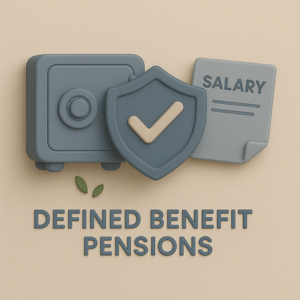
A defined benefit pension scheme promises you a pension based on a formula, not on how the stock market performs. The formula is usually built from:
Example: if you worked 40 years in a scheme with an accrual rate of 1/60th and finished on a £30,000 pensionable salary, you’d be looking at:
40 x 1/60 × £30,000 = £20,000 a year for life
In many schemes this income increases with inflation, which is why DB pensions are often called "gold‑plated".
If you leave a defined benefit scheme before retirement, your pension doesn’t disappear. Instead it becomes a deferred pension, which means it sits in the scheme until you’re old enough to take it. While it’s waiting, it usually gets a bit of an annual inflation-linked boost so it keeps some of its value. You won’t build up any more years of service once you’ve left, but what you’ve earned up to that point is safe. When the time comes to retire, you’ll still be able to choose things like a tax‑free lump sum or early payment (with a reduction).
You can ask for a cash equivalent transfer value (CETV), which is the lump sum the scheme would pay into another pension if you wanted to move it. This can sometimes look like a big number, but it’s because you’re giving up a guaranteed income for life. If the CETV is worth more than £30,000, the law says you must take advice from a regulated financial adviser before transferring. In some cases, like many public sector schemes, transfers out aren’t allowed at all. For most people, staying put is the safer option, but asking for a quote can help you see the value.
A DB pension is generally seen as very secure, because the responsibility for paying you sits with your employer and the scheme’s trustees. On top of that, there’s a safety net called the Pension Protection Fund (PPF). If your employer goes bust and the scheme can’t pay, the PPF steps in to cover most of your benefits. It’s not always the full amount you were promised—especially if you hadn’t yet reached pension age, but it gives a strong layer of protection compared to most other pensions.
Most DB schemes have a normal pension age, often 60 or 65, when you can take your benefits in full. But you don’t always have to wait that long, you can usually start as early as age 55 (rising to 57). If you take it early, the pension will be reduced, because it has to be paid for longer. Some schemes also let you delay taking your pension past the normal age, which can sometimes increase the amount you eventually get.
Every year your scheme should send you an annual benefit statement showing what you’ve built up and an estimate of what it might be worth at retirement. If you want to check in more often, you can usually contact the scheme administrator for an up‑to‑date figure. Bear in mind it’s not like logging in to see a pot value, because it’s a promise of income, not an investment account, so what you’ll see are income estimates rather than a balance.
Behind the scenes, DB pensions are looked after by trustees, who have a legal duty to act in the members’ best interests. They work with professional actuaries to calculate how much money needs to be set aside to pay everyone, and with investment managers to decide where the scheme’s assets are invested. The goal is to make sure there’s enough money coming in to meet all those future pension payments, sometimes decades into the future.
Yes, you can normally swap part of your annual pension for a tax‑free lump sum at retirement. This is called commutation, and the rate at which pension is exchanged for cash is set by your scheme (the commutation factor). For example, giving up £1 of pension per year might get you £12 or £15 of cash up front. The rules vary between schemes, but almost everyone can take up to 25% of the value tax‑free. It’s a popular choice for people who want an initial chunk of money for things like paying off a mortgage or enjoying an early retirement holiday.

The State Pension is a regular payment from the UK government once you reach a certain age. It is designed to give you a basic income in retirement, based on how many National Insurance contributions you have built up. Payments arrive every four weeks into your bank account. On its own, it is rarely enough for a comfortable retirement, it is a foundation that most people build on with workplace or private pensions.
Your State Pension age depends on when you were born. At the moment it is 66 for both men and women, but it is rising. For those born between April 1960 and March 1961 it will gradually increase to 67 between 2026 and 2028. For people born after April 1977 it is expected to be 68, and the government reviews these rules from time to time. Check your exact age using the official calculator at www.gov.uk.
The amount you get depends on your National Insurance record. As of April 2025, the full State Pension is £11,976 per year. To receive the full amount you need 35 qualifying years of contributions or credits. With fewer years you get less, and in some cases you can fill gaps. See your personal forecast at www.gov.uk.
You can improve your outcome by making sure you have enough qualifying years. If you have gaps, you may be able to pay voluntary National Insurance contributions to fill them. You can also defer claiming, which means delaying the start date. In return your payments increase slightly for every week you put it off, giving you a higher guaranteed income later.
Your State Pension is not automatic, you need to claim it. The quickest way is online at this page. You can also claim by phone or post if that suits you better. Aim to apply about four months before your State Pension age so everything is set up in time.
Once in payment, the State Pension usually rises each year thanks to the Triple Lock. It goes up by whichever is highest out of inflation, average earnings, or 2.5 percent. The goal is to help your income keep pace with the cost of living over time.
You may pay Income Tax on your State Pension, depending on your total income. If all of your income is below the Personal Allowance, you will not pay tax. If it is above that, you pay tax on the amount over the allowance. You do not pay National Insurance once you reach State Pension age. If you are employed you should tell your employer, and if you are self employed you stop paying Class 4 contributions from the start of the tax year after reaching pension age.
For detailed guidance, see Tax and National Insurance after State Pension age.
Yes, you can. This is called deferring your State Pension. If you do not claim it at State Pension age, it keeps building in the background. For every nine weeks you delay, your payments increase by about 1 percent, which works out at roughly 5.8 percent for a full year. It can make sense if you are still working, or if you want a higher guaranteed income later.
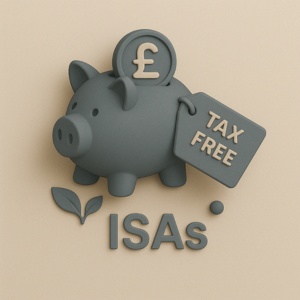
An Individual Savings Account (ISA) allows you to protect your savings from tax. Like with a pension, you don’t pay tax on any interest, dividends, or capital gains earned within an ISA. But unlike a pension, you can withdraw money from an ISA at any time without penalty. This is because you have already paid income tax on any contributions you make.
Each tax year (from 6 April to 5 April), you can pay in up to £20,000 across your ISAs. You can split this between different types, but only contribute to one of each type per year. All growth or returns within the ISA are tax-free.
You can choose your own investments or use ready-made portfolios based on your risk level. All growth, dividends, and withdrawals are free from UK tax, which makes it a powerful way to grow wealth over time.
Here are a few ways you can use ISAs alongside your pension strategy:
For the 2025/26 tax year, the total ISA allowance is £20,000. This can be split between different types of ISA but the maximum for a Lifetime ISA is £4,000.
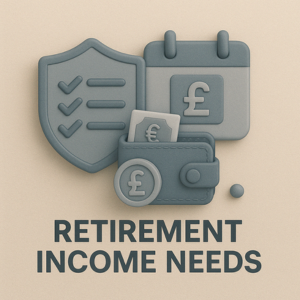
The Retirement Living Standards website offers a practical framework to help you estimate the income needed for your desired lifestyle in retirement. The standards show you what life in retirement looks like at three different levels: Minimum, Moderate and Comfortable and what a range of common goods and services would cost for each level.
The Retirement Living Standards were developed using the Minimum Income Standard (MIS) methodology by the Centre for Research in Social Policy at Loughborough University, on behalf of the Pensions and Lifetime Savings Association (PLSA).
This approach is grounded in public consensus, not expert opinion. A total of 249 people over age 50 (retired and not-yet-retired) took part in detailed group discussions across the UK. They agreed on what goods and services are needed for the three different lifestyles in retirement: Minimum, Moderate, and Comfortable.
Each lifestyle was defined through “baskets” of items like food, transport, clothing, holidays, and social activities. For example, at the Comfortable level, participants included frequent holidays, branded groceries, and regular dining out. The Moderate level included some financial flexibility and modest treats, while the Minimum level covered essentials with limited extras.
These baskets were then costed using real-world prices from actual retailers. The resulting figures were converted into weekly and annual income requirements, with separate figures for singles and couples, and for London and the rest of the UK.
The net retirement income required each year for each of the three standards of living for 2025 is as follows:
| Category | Minimum | Moderate | Comfortable |
|---|---|---|---|
| Single Person | £13,400 | £31,700 | £43,900 |
| Couple | £21,600 | £43,900 | £60,600 |
The equivalent monthly income levels are:
| Category | Minimum | Moderate | Comfortable |
|---|---|---|---|
| Single Person | £1,117 | £2,642 | £3,658 |
| Couple | £1,800 | £3,658 | £5,050 |
The retirement living standards are a useful guide to typical spending in retirement, but you should be aware that certain items are not included in the figures:
While the retirement living standards offer a helpful benchmark, there are important limitations to keep in mind:
You can adjust the standards of living income requirements for your own circumstances using the Retirement Budget Calculator.
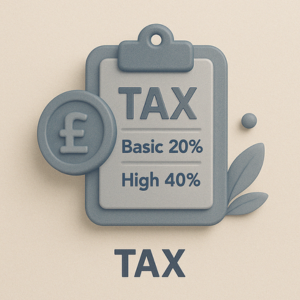
Income tax is a tax on earnings from salary, self-employment, pensions, and other income. There are several bands that are taxed at different rates. These are the bands for the 2025/26 tax year in England, Wales, and Northern Ireland:
If you earn over £100,000, your Personal Allowance is gradually reduced — for every £2 of income above £100,000, you lose £1 of allowance, meaning it is fully removed at £125,140.
Scotland has different income tax bands and rates from the rest of the UK, set by the Scottish Parliament. These are the rates for the 2025/26 tax year:
The gradual reduction of the Personal Allowance above £100,000 still applies in Scotland, just as it does in the rest of the UK.
National Insurance is a tax paid by employees, employers and the self-employed. It helps fund state benefits such as the state pension, statutory sick pay, and maternity leave. The amounts to be paid are calculated as follows:
Pension tax relief is a government incentive to encourage people to save for retirement. It means some of the money that would have gone to the government as tax is instead added to your pension pot.
How you claim depends on how much you earn and the type of pension scheme you have. It may happen automatically.
Yes, in most cases you can take part of your pension tax free when you start to access it. This is known as the tax-free lump sum or pension commencement lump sum (PCLS).
Your state pension is treated as taxable income, but it's paid to you without any tax deducted at source. Whether you pay tax on it depends on your total income from all sources.
Carry forward is a pension rule that allows you to make contributions above the standard annual allowance by using any unused allowance from the previous three tax years — provided you were a member of a UK-registered pension scheme in those years.
Lump sum recycling refers to a situation where someone takes a tax-free lump sum from their pension, known as the Pension Commencement Lump Sum (PCLS), and then reinvests some or all of it back into their pension to gain additional tax relief. HMRC has strict rules to prevent this from being used to gain unfair tax advantages.

For defined contribution pensions, your main choices are:
For defined benefit pensions, you only really have two choices:
An annuity is a insurance product you can buy with some or all of your pension pot. It gives you a guaranteed income for life (or for a fixed period), no matter how long you live. There are several options you can choose when setting one up, depending on your needs and preferences:
Note: Once you buy an annuity, the decision is usually permanent. It’s important to shop around for the best rates and options using the open market. Your health and lifestyle can also affect the income you’re offered — some people qualify for a higher ‘enhanced annuity’ if they have certain conditions.
Pension drawdown (also called flexi-access drawdown) is a way of taking money out of your pension pot once you are 55 or older (rising to 57 from 2028). Instead of buying an annuity, which gives you a guaranteed income for life, your money stays invested and you can choose how much to withdraw and when.
This gives you lots of flexibility – you could take a regular monthly income, occasional lump sums, or leave it invested to (hopefully) keep growing. The flipside is that your pot is exposed to investment ups and downs, so if markets fall or you take out too much too quickly, your money could run out.
You can usually take up to 25% tax-free (either all at once or in smaller chunks), and the rest is taxed as income. For many people, drawdown works well as a way to balance steady withdrawals with keeping options open, but it does mean you need to keep an eye on how your investments and withdrawals are working together over time.
Uncrystallised Funds Pension Lump Sums or UFPLS ("uff-plus") is a complicated name, but what it means for your retirement income is relatively simple. It is effectively the same as having 25% of each pension withdrawal tax-free. It can be tax efficient compared with taking your tax free lump-sum in one go at retirement because as your pension fund grows during your retirement, the tax-free element of each withdrawal also increases. However, it does limit your future pension contributions.
Here's how it works:
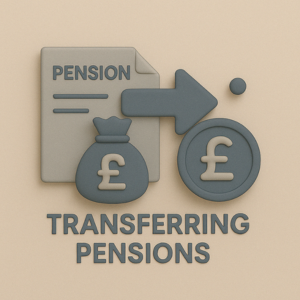
Potential Benefits of Combining Pensions:
Transferring a defined benefit (DB) pension is rarely recommended due to the loss of guaranteed income. However, some people may still consider it for the following reasons:
Important: Transferring is irreversible and high-risk. Regulated financial advice is legally required for transfer values over £30,000.
Transferring a defined contribution (DC) pension is usually simpler than a defined benefit transfer and doesn't require advice unless special guarantees are given up. Reasons for considering a DC transfer include:
Common Pension Transfer Charges
If you’re transferring a defined benefit pension worth over £30,000, regulated financial advice is required by law. It’s also wise for any complex transfer decisions.